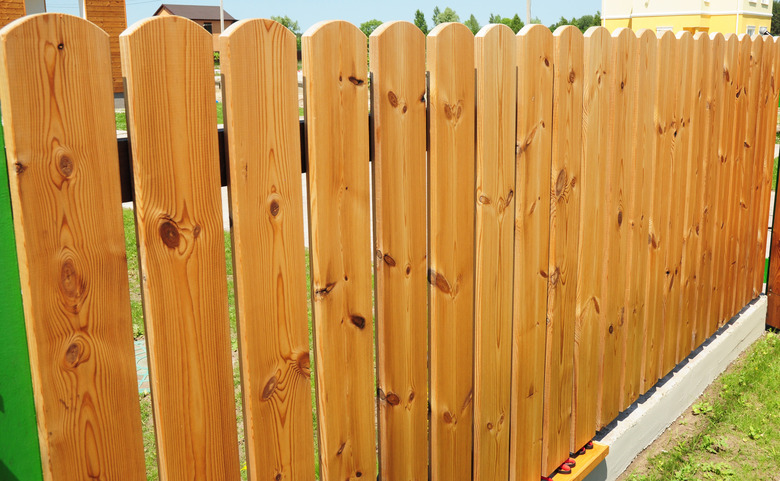How To Install T Post Fencing
If you have an area that requires fencing to keep pets or livestock in or out, T posts are a reliable, cost-effective and easy-to-install solution. These metal posts have hooks for mesh or wire fencing, are available at most ranch and home supply stores and come in several different heights. Using T posts makes installing a durable wire fence an uncomplicated procedure that can be accomplished with only a few simple tools and supplies.
Buying T Posts
Buying T Posts
Purchase enough T posts to allow spacing of 8 to 12 feet apart. In general, the larger the livestock being contained, the closer the posts should be to each other. T posts up to 6 to 8 feet in height generally cost approximately $4 to $5 each. The pricing may vary depending on the height of the post, regional availability and number of posts purchased.
Additional Fencing Materials and Tools
Additional Fencing Materials and Tools
Wooden posts should be used in groups of three on the corners of the fenced area. Every tenth T post should also be replaced with a wooden post for strength and stability, and posts that will support any gates should also be wood. Fencing can either be heavy gauge metal wire or metal mesh. You'll also need lag bolts, wire staples, wire clips and T post caps.
Tools you will need include a post hole digger, a shovel, a T post driver, a come-along to stretch the wire, wire grips, fence pliers, wire cutters, a plumb line and a hammer. Concrete can be purchased if you want extra stability for the wooden posts. In that case, you'll need a mixing container and mixing tools.
Lay Out All Posts Along Fence Line
Lay Out All Posts Along Fence Line
To ensure you have the correct number of posts and the correct spacing, lay your posts out on the ground around the perimeter of your planned fence line. Place one wood post at each corner of the area being enclosed. Also, set the wood posts in place of every tenth post and on either side of the intended gates. The rest of the posts will be T posts.
Install Wood Posts
Install Wood Posts
Install the wood posts first. Use a post hole digger to create holes approximately half as deep as the height of the posts and 2 to 4 inches wider in diameter than the posts. The wood posts can be set on top of 6 inches of gravel and securely backfilled with tightly packed dirt or set on 6 inches of gravel and backfilled with 6 inches of concrete. Allow the concrete to cure for 24 to 48 hours before backfilling with dirt.
Attach diagonal wood braces to support the corner posts by notching the corner post approximately 2 feet from the ground, putting another piece of post into it at an angle to the ground and burying the bottom of the diagonal post. Attach the top end of the brace to the corner post with a lag bolt. Do the same for any wood posts designed to bear extra weight, such as gate posts.
Install T Posts
Install T Posts
For fences designed to keep animals in, face the hooked side of the post inward. For fences designed to keep animals out, face the hooks outward. Drive each T post 18 to 24 inches into the ground with a T post driver, checking for plumb every 4 inches or so.
Install Wire
Install Wire
Wire can be looped around the corner post and fastened in place with wire staples. Leave an 18-inch tail and form it into a loop with pliers, twisting the end back on itself to close the loop securely. This loop can be left hanging and used as an anchor for the come-along at a later date if the wire needs to be re-stretched.
Unroll the wire to the next corner post, wrap it half around the post and attach a wire grip. Use the come-along to stretch the wire taut between corner posts, then wrap the wire completely around the post and fasten with a couple of staples. Cut it to leave an 18-inch tail to form a loop. Repeat for each strand of wire until all three to five strands have been run.
If you have designated openings for gates, a single fence line may need to be run in two or more sections, so each section of fencing is tight and the gate or gates can be installed to the wooden posts set for that purpose.
Connect Wire to the T Posts
Connect Wire to the T Posts
Use the wire clips to attach each strand of wire to the T posts. Slide the wire clip on from the back side of the post and use fence pliers to secure the clip around the wire. Repeat for each strand of wire at each point it meets a T post. When a wooden post is encountered, use staples to secure the wire to the post. Cap each T post with a safety cap.
Repeat the above processes until all fence lines are complete. Wire mesh can be attached to the T posts in the same way as wire strands, or installed at a later date and attached directly to the wire strands and the wooden posts. Once complete, your T post wires can be retightened every year or so to keep the fence stable and effective.
